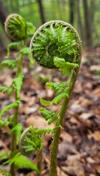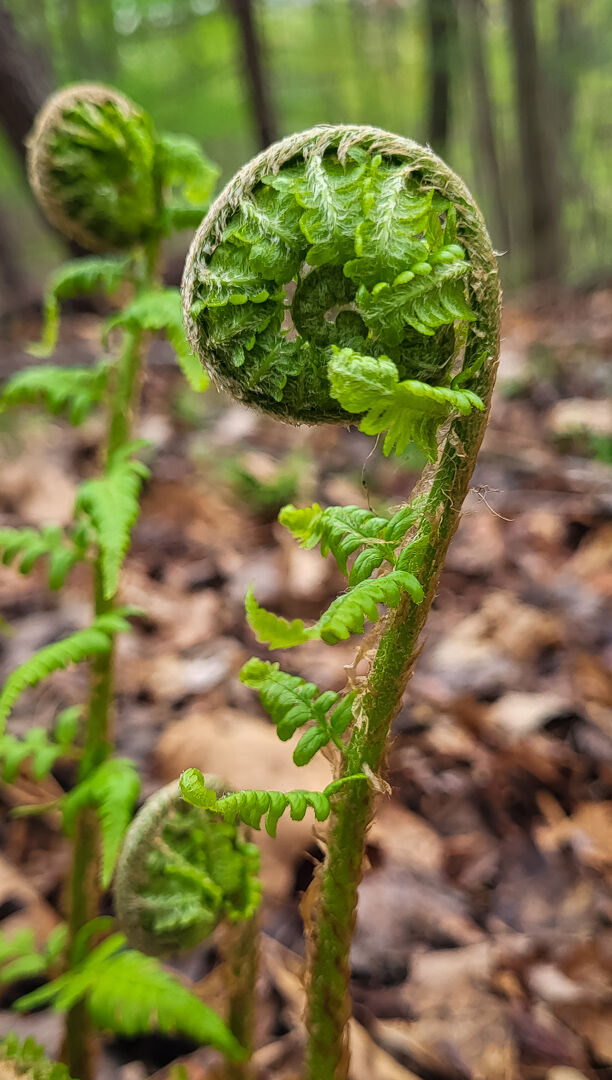With Summer here, we’re taking a look back on thoughtful observations when spring crept in…
Spring in the Allegheny foothills arrived slowly, with two steps forward and one step back into winter. After spending a week with my brother in Tucson in late April, watching the Sonoran Desert bloom in scorching heat, I came back in May and summed up the changes that had occurred here since I left. Most of the species here I’ve also seen in Rappahannock County or should be endemic there.
Flora
This small property (3.5 acres) at more than 1,300 feet above sea level and heavily wooded, reminds me of a zoo — diverse in the species it hosts but with only small populations of most of them.
When my friend and I moved here last July, the forest floor was almost devoid of herbaceous plants and woody seedlings, likely eaten by the deer living here. With the invasion of two humans, three dogs and a growing flock of chickens, the deer moved on and plants are now popping up all through the forest. While thousands of bloodroot and other amazing spring ephemeral species covered the damp, rich mountain slope in Old Hollow, where I used to live, only a few of these have emerged here so far (May 1).
Ferns were among the first native plants to come up, with several large patches of New York fern. Though lovely, this species can be invasive, so I’ll be keeping an eye on them. Fresh fronds of the sensitive fern are emerging amid the species’ leathery, brown fertile fronds left from last year. The latter are covered with bead-like spore sacs. Springtime humidity triggers the release of the spores, which travel on the wind to spread the species.
I was happy to find a lot of rattlesnake ferns, one of my favorites, and more fiddleheads of various fern species keep popping up to join the spring show. No fern expert, I’ve been using a couple of inexpensive but useful fern guides — “Identifying Ferns the Easy Way” and “Fern Finder” — to help with ID, which will be easier once the spores develop.

wildFiddlehead-4-2-web.jpg
Fiddleheads
As in Old Hollow, Robin’s plantain and other fleabanes were among the first plants to flower here. Solomon’s seal and other lookalikes are also coming up, which will be easier to sort out once they develop buds. I also found a single rue-anemone and a lone patch of tiny Virginia saxifrage waving their delicate flowers on the end of long stems. Hooked buttercup and kidneyleaf buttercup are also blooming.
I was surprised to find one of my favorite native shrubs, a black haw (a viburnum), blooming in the middle woods. With the canopy now rapidly closing over it, its two beautiful blooms will likely be the only ones this year. The few redbuds up here finally flowered and have now leafed out, with native dogwood and other woody plants following them. Two warm days the third week of April seemed to kick-start some other, more-reluctant ones, such as oaks.
Fungi
Deluges of rain last summer and early fall triggered large and diverse mushroom blooms, but few mushrooms have popped up so far this year. Amber jelly roll (Exidia recisa), a jellylike mushroom has bloomed on elderly trees during warm spells all through the winter, but it wasn’t until the third week in April that I found another fungus in bloom — the bizarre-looking devil’s urn (Urnulacraterium). It has leathery, cuplike reproductive bodies that are black inside, and black and brown on the exterior.
Recent rains had left pools of water in the cups, reflecting the sky above. As I was photographing them early one morning, puffs of what appeared to be spores, or perhaps steam from the rising sunlight hitting the water, came from a couple of the cups, but I wasn’t fast enough to photograph them. As rainy days are more frequent and temps rise, I’m hoping the ground will explode with more mushrooms soon.
Fauna
With no vernal pools on the property suitable for wood frogs, I missed their quacking chorus in Old Hollow during warm spells in winter and early spring. But on warm evenings, the sound of chorusing spring peepers has drifted in from a small wetland bordering the forest here. Warm days have also brought the slow trill of a few gray treefrogs; their numbers and pitch should go up once the temperature does, encouraging them to lay their eggs in our meager little “water features,” as they did last year.
For a while, even on cool nights, I was hearing a mysterious slow, low, creaky sound coming up from the forest floor, like the sound of dragging something across the teeth of a comb. In checking anuran calls on the Virginia Herpetological Society website, the only species I found whose call similar to the one I’ve been hearing and that could breed up here is the upland chorus frog (Pseudacris feriarum). Like most frogs in its genus, this one is tiny, well-camouflaged and goes silent at any hint of a predator. We saw no sign of snakes last year, and it’s still too cold up here for reptiles to be active, but I’ve dug my snake boots out of my closet in preparation for hiking in the woods as temperatures rise.
Bees were among the first insects to arrive this spring, swarming the flowers of introduced shrubs that bloom before our natives do, and butterflies have come and gone on warm days. A lack of rain more than temperature seems to have hindered some other invertebrates, although I did find a nice little snail (Discus catskillensis?) out one cloudy but warm day. On a warmer, sunny day, I spotted a tiny assassin bug nymph sucking the life out of a tinier fly on the leaf of a white oak seedling. And my housemate’s chickens are finding more earthworms under the leaves in the forest, thanks to recent rains.
Some of our winter avian visitors are starting to head further north or up in elevation, while spring breeders are arriving. I’m still keeping an eye on the red-shouldered hawk and gray squirrel families we’ve been monitoring here. Look for an update soon, and visit the Photo Diary on my blog, wildideas.us, for more shots of spring arrivals as I take them.
© 2023 Pam Owen
Birds migrating in and out
Some of the winter birds that had been mobbing our feeders — especially purple finches and slate-colored juncos — appeared to have moved on to their cooler breeding grounds in the mountains or to the north. That may be the case of one of my favorite birds, the red-breasted nuthatch, which although not uncommon, I hadn’t seen before I moved here. Two hung around until the last few days but may have gone further up, in the Alleghenies, to breed.

wildNuthatch-4-2-web.jpg
The red- breasted nuthatch
Meanwhile, species that do breed in the area are returning. A pair of chipping sparrows was among the earliest to arrive. Two of my favorite avian singers — wood thrush and eastern towhee — are back, and a brown thrasher also stopped by to regale us with a symphony of songs, mostly borrowed from other birds.
By April 25, a scarlet tanager had returned and was adding to the morning chorus. The gorgeous scarlet-and-black males are awesome to behold. Two oven birds — the first warblers to arrive — started loudly proclaiming their arrival a few days later. On warm days, I’ve heard eastern meadow larks and field sparrows singing in the hay meadow next door.
Some of the year-round birds have already paired up and begun nesting. Others are still courting. A pair of eastern bluebirds are still here, and I just saw two tufted titmice adults feeding what appeared to be a third adult, which was soliciting food. Is this an avian throuple or just a courting competition between two males for a female?
A flock of up to a couple dozen American goldfinches that had been mobbing the feeders all winter has dwindled down to just one or two. Considering the property is mostly forested and goldfinch mainly eat seeds of native grasses and flowers, that may be all we see until next fall. Goldfinches usually start nesting in June, when seeds are more available, but the large winter flocks usually split up well before that.
A barred owl that had frequently serenaded us last summer and fall but apparently went to another part of its territory to mate this winter has come back. On a recent night, I heard it calling its usual “who cooks for you?” Then suddenly, a terrible jumble of shrieks and calls occurred just a few yards from the house. From the sound, I think another barred owl tried to trespass on our guy’s territory, but the excitement was over before I could go check. Recently, I’ve heard only a bit of its song from neighboring property, but I hope it comes back up here.
I put out the hummingbird feeder a week later than usual, on April 12, after I got back from Arizona. It didn’t take long before a male ruby-throated hummingbird showed up, soon followed by another one. The males return first, but the females shouldn’t be far behind. And more summer breeders should show up soon.
Sign up for Rapp News Daily, a free newsletter delivered to your email inbox every morning.
Subtext




